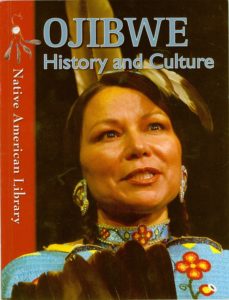Book review: Ojibwe: History and Culture
Ojibwe: History and Culture by Helen Dwyer and Sierra Adare, is a nicely illustrated work on glossy paper aimed at upper year grade school and highschool students. It consists of an introduction five chapters, timeline, glossary, and two pages of additional sources (web and published). Unfortunately, the glossary includes English language terms only and the book is primarily American in focus, with minimal reference to events in Canada.
Interesting text boxes of important people, events, and Anishinaabeg words do appear throughout the book. For instance, a text box in Chapter 1 contains a list of eight (8) Ojibwe words, their pronunciation, and English translation. Chapter 2 contains a text box that highlights the Robinson Superior Treaty; however, the box fails to note that many of the Lake Superior Bands did not sign the document. The few maps contained within the chapters are coloured and accurately show our historic territory (10) and current reserves in Canada and the United States (30).
The introduction begins with the Western theories of Beringia that are phrased so the theory appears to be a tentatively drawn conclusion. Yet this tentative phrasing falls within the section that calls Indigenous peoples “The First Immigrants” with certainty. To reinforce the idea of migration, a single sentence in the introduction under the section “First Immigrants” states, “The Ojibwe believe they migrated from the East Coast … to the Great Lakes.” Any further discussion of our place on Turtle Island is confined to two paragraphs on our origin story.
The constant reference to the idea that the Anishinaabeg were “forced” to migrate, trade, sign treaties, adopt Christianity, and so forth serves to cast us a people unable to contest, alter, or adapt to changing circumstances. While ‘force’ is an easy narrative to explain the past from European contact to today, it undermines Ojibwe’s efforts to show complexity and our positive roles within the past (i.e., our constant contesting of colonialism).
Chapter 4, “Ojibwa Life Today”, offers a wonderful highlight of our contemporary lives and activities. This chapter’s discussion of how First Nations select leaders in Canada is vague and misrepresentative of the process; nonetheless, by placing it alongside the U.S. system, one does see that the Anishinaabeg in both countries are using slightly different imposed governance systems. Even with these issues, chapters one through five ably show the Anishinaabeg in both the historical and contemporaneous context that illustrate culture continuity in the face of change.
I particularly liked the fourth chapter’s brief discussion of contemporary art and literature. It showed the connection and influence of our past, our culture, and our contemporary experiences in fostering ongoing creativity. Importantly, it illustrates how both art and literature are driving a cultural renaissance while encouraging First Nations and Settlers alike to engage with our history and culture to make the present and future better. I also like the relevance of the historic and contemporary photographs and illustrations to supplement the text. The images were used in an attempt to as accurately as possible portray the Ojibwe while avoiding stereotypes and negativity. This is an indication of the care generally taken in researching, writing, and illustrating Ojibwe.
Overall, Ojibwe is a good introductory text for its audience. I would suggest, however, that for the classroom, the introduction be tempered by starting with our origin stories followed by Western stories of our origins. This would ideally be followed by a discussion of both. In Canada, the text would also need some supplemental materials relating to local, regional, or national Anishinaabeg context. For instance, it would need a rounder discussion of the 1850 Robinson Treaties or another treaty depending on where the school is located. I would note that such supplementation for most works about the Anishinaabeg is necessary when used in teaching. Regardless, I recommend that Ojibwe be used in schools and at home as a nice introductory source of information.
Helen Dwyer & Sierra Adare. Ojibwe: History and Culture, New York: Gareth Stevens Publishing, 2013.


